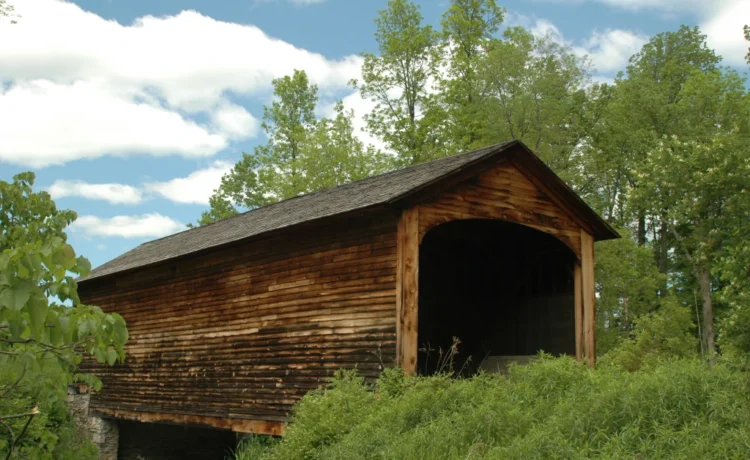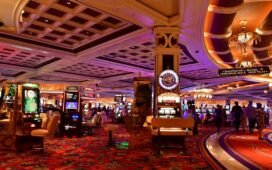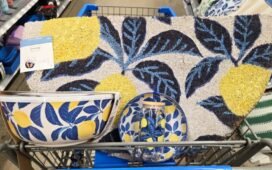
 This year’s 200th anniversary of the Hyde Hall covered bridge in Glimmerglass State Park near Cooperstown in Otsego County, NY, the oldest covered bridge still standing in America, is being celebrated on October 11, 2025. It’s all traceable to George Clarke (1768-1835).
This year’s 200th anniversary of the Hyde Hall covered bridge in Glimmerglass State Park near Cooperstown in Otsego County, NY, the oldest covered bridge still standing in America, is being celebrated on October 11, 2025. It’s all traceable to George Clarke (1768-1835).
Clarke, whose family property empire included tens of thousands of acres in New York, England, and Jamaica, bought land in Cooperstown in 1817. It was on and above Otsego Lake, eight miles north of Cooperstown and with a commanding, majestic view of the lake and the surrounding countryside.

 With the aid of one of the most prominent New York architects of the time, Philip Hooker (1766-1836) of Albany, Clarke set about building a grand country estate, a process that would fully take several decades. Hyde Hall was built for Clarke and named after his estate in England.
With the aid of one of the most prominent New York architects of the time, Philip Hooker (1766-1836) of Albany, Clarke set about building a grand country estate, a process that would fully take several decades. Hyde Hall was built for Clarke and named after his estate in England.
[Clarke was the great grandson of George Clarke (1676-1760), who served as acting governor of the colony of New York from 1736 to 1743. This family owned large sugar plantations in Jamaica which relied on the labor of enslaved people.
When Clarke inherited his great grandfather’s fortune and lands in New York he moved to Albany in 1806. His ownership of much of these lands was heavily disputed, until he finally secured title through the U.S. Supreme Court in 1818.]
By the early 1820s, Hyde Hall’s main Stone House was complete and occupied by family. It was time to improve its approaches. Clarke faced a smaller but important building project: a relatively short bridge to act as an entrance to the estate.
For this project, Clarke decided on a wooden covered bridge — a type of construction still in its early years, with the first known American covered bridge having been built in 1805 over the Schuylkill River in Philadelphia.

 In choosing to build a covered bridge, a kind of structure quite new in America, Clarke was doing something unusual and innovative. The late Douglas Kent, a long-time historian of Hyde Hall, describes how Clarke chose to build a covered bridge, not because it was the easiest engineering or design solution, but because it was the most dramatic:
In choosing to build a covered bridge, a kind of structure quite new in America, Clarke was doing something unusual and innovative. The late Douglas Kent, a long-time historian of Hyde Hall, describes how Clarke chose to build a covered bridge, not because it was the easiest engineering or design solution, but because it was the most dramatic:
“This bridge was placed exactly here for a calculated effect. A simple, uncovered span would have done merely to cross Shadow Brook. It could have been placed anywhere along the stream’s course, but it would not have provided the surprise of sudden discovery, the thrill of entering the tunneled gloom, of rattling through it into light and the open field beyond.”
Many of the first covered bridges in America were long ones, hundreds of feet, spanning wide rivers. But what was needed on the Hyde Hall property was something far shorter, 53 feet, to span Shadow Brook.
Ever since they were first built, covered bridges have been a source of fascination and romance. Bridges were covered for a functional reason—to protect the underpinnings from moisture. Even though the primary reason for covering bridges is utilitarian, other lore has emerged.
Covered bridges are treasured reminders and symbols of quieter, simpler days. “Kissing bridges” is a colloquial term for covered bridges, referencing the tradition of couples lingering in secluded spans for a kiss while traveling in horse-drawn carriages.
About 14,000 covered bridges have been built in America since the first one over the Schuylkill River in Philadelphia in 1805 (which was replaced in 1850). Over time, many bridges were removed because they had exceeded their useful life.
Others were replaced because of the demands of modern traffic. With determined preservation work during the past 75 years, about 650 historic covered bridges remain today. None before the Hyde Hall bridge has ever turned 200 years old.
[While the original covered bridge at Waterford, NY, which was built in 1804 was replaced, its early 19th-century abutments and piers still stand in the Hudson River, making them over 200 years old.]
For the bridge project at Hyde Hall, Clarke turned to three men who already had ties to him: master carpenter Cyrenus Clark, local carpenter Andrew Alden, and stone mason Lorenzo Bates.

 The best available surviving records suggest that the bridge was built in about a year and was finished in 1825. The cost appears to have been less than $10,000 (roughly $327,250 in 2025).
The best available surviving records suggest that the bridge was built in about a year and was finished in 1825. The cost appears to have been less than $10,000 (roughly $327,250 in 2025).
The type of truss used to bear the bridge’s load has been characterized in several different ways, but in recent years it has been labelled as a “Burr truss bridge,” a reference to the design work of Theodore Burr, one of the best-known American bridge engineers of the early 1800s.
Hyde Hall’s bridge is unusual in that it has horizontal siding, rather than the vertical siding that most covered bridges have used in the United States.
The Hyde Hall covered bridge served for many years as the entrance to the estate of Clarke and his family. As such, it was used by luminaries who visited the Clarkes, such as Theodore Roosevelt, Franklin and Eleanor Roosevelt, Samuel F.B. Morse, and Girl Scouts founder Juliette Gordon Low.
More recent visitors to the bridge include Senator Daniel Patrick Moynihan, Governor George Pataki, Laurence Rockefeller, and many actors, such as Paul Newman, Joanne Woodward, Cliff Robertson, Brad Pitt, and Shirley Jones.
New York State acquired Hyde Hall and the surrounding property in 1963, creating Glimmerglass State Park. Under the supervision of the New York State Office of Parks, Recreation and Historic Preservation (State Parks), the state has performed repairs to the bridge and made many improvements to the site over the years, supplemented by extensive volunteer efforts.
The bridge stopped carrying auto traffic in 1965 when the entrance road to Glimmerglass State Park was constructed and a new concrete bridge built downstream, just to the west.

 When the state acquired the Hyde Hall property, the bridge was in poor repair, with holes in its roof and siding, and loss of one-half the floor boards.
When the state acquired the Hyde Hall property, the bridge was in poor repair, with holes in its roof and siding, and loss of one-half the floor boards.
In 1967, the state launched an extensive restoration, making a special effort to use materials that matched the original bridge as much as possible. The Hyde Hall Covered Bridge was added to the National Register of Historic Places on December 17, 1998.
Bob and Trish Kane, leaders of many recent restoration and beautification efforts at the bridge, held an event on July 17, 2016, to celebrate further repairs to the structure, such as the application of fire retardant, enhancements to the area around the bridge, and a new interpretive sign.
As the Hyde Hall bridge enters its third century, the New York State Covered Bridge Society and the National Society for the Preservation of Covered Bridges have been active in supporting the preservation of the bridge.
This year’s bicentennial celebration of Hyde Hall covered bridge takes place on Saturday, October 11th from 10 am until 4 pm. The free event includes music from old time music specialists and students at Cooperstown High School; a classic car show; children’s activities; horse and buggy rides; speeches marking the 1825 bridge at 1 pm; and special presentations about the history of wooden covered bridges and also the Cooperstown area. A schedule of events will be available at the entrance to Glimmerglass State Park on October 11.
A souvenir booklet about the Hyde Hall bridge will be available, along with a special edition postcard with a unique cancellation in honor of the bridge’s celebration. Food and drink will be on sale.
Glimmerglass State Park and Hyde Hall State Historic Site are hosting the celebration, along with the New York State Covered Bridge Society, the Theodore Burr Covered Bridge Resource Center, the National Society for the Preservation of Covered Bridges, and other organizations devoted to the history and preservation of covered bridges.
Read more about covered bridges in New York State.
A version of this essay by freelance writer and journalist Noel Rubinton, first appeared in the New York State Parks and Historic Sites Blog.
Illustrations, from above: The Hyde Hall bridge in 2006 (photo by Trish Kane); detail from a portrait of George Clarke painted in 1829 by Samuel F.B. Morse (Saint Louis Art Museum); Hyde Hall mansion and grounds (State Parks); inside the Hyde Hall Covered Bridge showing the Burr truss and horizontal siding (photo by Bill Caswell); and the bridge in 1962, still open to vehicle traffic (photo by Grant Musser).








Recent Comments